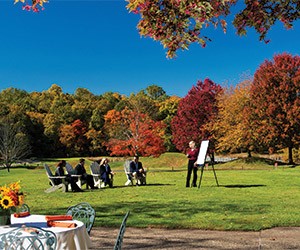Conference centers designed for serious meetings, particularly those that are members of the International Association of Conference Centers (IACC) and adhere to it its strict tenants, might seem somewhat immune from economic recession and perception issues stemming from the AIG effect.
After all, members include university and non-residential day conference centers as well as upscale resorts and hotels. But it is not that simple: venues focused more on training and learning are now facing greater competition—some of it from upscale properties offering discounted rates.
According to conference center consultant Dave Arnold, CEO-East for PKF Consulting, few conference centers have escaped the impact of the economic downturn.
"Some are doing worse than others," he says. "Resorts, which were demonized, are suffering the most. Those [conference centers] that rely on corporate meetings are impacted the most after resort conference centers. Those focused on training are probably doing the best."
PKF Hospitality’s Conference Center Trends 2009 report, issued last June, found IACC-member conference centers in a "coping mode." It found that 2008 consisted of three parts: normal operations for two quarters, a transition decline during the third quarter and a collapse of the core business meeting market in the fourth.
In 2008, IACC’s North America residential conference centers had an average occupancy of 57 percent, down 2.9 percent from 2007. Of four categories—executive, corporate, resort and college/university—only college/university had an occupancy increase (up 5.9 percent).
The average daily rate for all categories was up 2.6 percent. College/university centers posted a rate increase of 0.6 percent, the lowest of any category.
Revenue per occupied room increased 1.2 percent from 2007 to 2008, demonstrating, according to PKF, "the importance of the conference center business model where the package rate helps support overall revenues."
According to Arnold, although demand will recover gradually over the next few years, room and Complete Meeting Package (CMP) rates are likely to lag behind the recovery, as has happened in prior recessions.
"There has been so much erosion in pricing, it could be three or four years before we recover to pre-recession levels. Occupancy has to stabilize first," Arnold says.
Optimistic Outlook
Despite a difficult year, there is cautious optimism among conference center operators and site selection firms.
Dolce Hotels & Resorts, which has 24 hotels, resorts and conference centers in North America and Europe, has seen shortened stays, smaller meetings, more day meetings and a little less spent on F&B, according to Barry Goldstein, chief revenue officer.
"The greatest drop-off by far has been in corporate business," he says. "No market has held up, but government and SMERF business has held up best. We’ve seen some stabilization and a little more activity. For 2010 we’re seeing RevPAR still flat but more opportunity for occupancy."
Last fall, Dolce launched the "Make Us an Offer…. Anything Goes" campaign, challenging meeting planners to name the price they would pay for an entire package, for meetings held through May 31, 2010.
"We’ve had a lot of success with it—a 25 percent increase in leads," Goldstein says. "We’ve had a lot more interest from corporations. In some conversations with customers, we typically find their meetings are on hold. This has helped and it gives us an opportunity."
Peter Regan, director of sales and marketing at Wyndham Virginia Crossings Hotel & Conference Center near Richmond, Va., says that the property’s booking pace is up in comparison to a year ago, with the greatest success coming from the state association market.
"We are especially excited about the increased interest level for clients discussing dates a year out," he says. "Corporate business has become increasingly short term. It’s not uncommon for inquires to be literally a week out from arrival.
"We’ve revisited the concept of prospecting with an emphasis on creating ‘Google Alerts,’ which allows us to seek out links to qualified business opportunities that would be suitable," Regan adds. "We have identified over 150 programs since the summer that will consider us in the future."
Nancy Crook, director of national accounts for EMCVenues, also says business is picking up, with properties continuing to offer attractive rates and value-adds.
"We are seeing lower rates across the board, of course," she says. "We are also seeing creative concessions from various properties—percentage credits back to the master are especially popular right now. The brands seem to be taking the initiative at the corporate level to streamline the discounts and packages offered.
"While there are some perception issues with resorts, lower rates all around have made some higher end properties within reach of companies that might not have considered them two years ago."
Michele Nichols, founder of Unique Venues, reports that her company is getting more corporate leads.
"We are trending up in a lot of areas," she says. "Planners are looking at more venues during their visit to uniquevenues.com. Our leads are up a monthly average of 11 percent, interestingly with about 42 percent coming from the corporate market."
Unique Venues has about 630 member properties ranging from conference centers to museums and arenas. More than half are university and college facilities.
"Universities have always been more affordable and low frill. It makes a lot of sense to meet on a campus," Nichols says.
—Tony Bartlett has been writing for travel industry publications for over 20 years.






